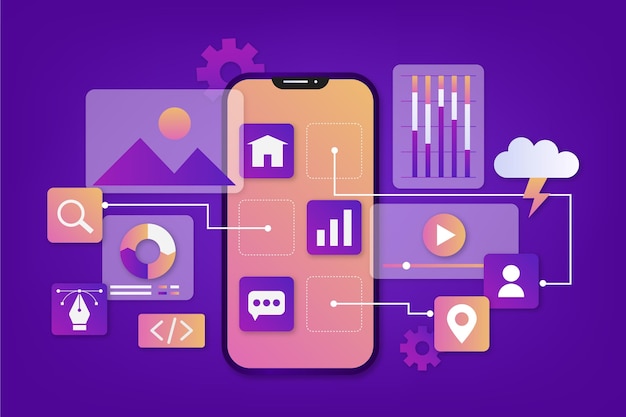Introduction to Enterprise Application Integration: Concepts and Importance

Photo by freepik @ freepik
Enterprise Application Integration (EAI) is often overlooked when discussing modern heavy-duty enterprises' smooth operation. Yet, in an age when data has become the new oil, EAI's integration across applications within an enterprise becomes both necessary and strategic advantage. This blog explains key concepts and benefits of EAI for enterprise solution architects and IT decision-makers navigating complex landscapes like that of an enterprise solution provider.
What Is Enterprise Application Integration (EAI)?
Ever wondered, what is enterprise application integration? Well, Enterprise Application Integration, more commonly known as EAI, involves connecting different software applications and systems within an enterprise in order to make them work together seamlessly. Heavy-duty enterprises often face the daunting task of managing numerous apps spanning across departments (CRM systems, ERP software, and supply chain management tools among them), so EAI provides an essential way of streamlining operations by creating one centralised system where these apps can interact and share data efficiently to improve data flow and operational efficiencies.
EAI typically utilises middleware. Software that acts as a liaison between various applications, enabling them to exchange data and perform functions collaboratively to help enterprises avoid siloed data and disjointed operations, especially large organisations that must handle vast volumes of information that requires real-time processing with real-time accuracy. Integration such as this is particularly essential in large organisations that must manage massive volumes of information where real-time processing with accuracy is greatly beneficial and vitally necessary.

Imagine an enterprise using multiple applications for sales, finance, and customer support. Without EAI these systems would operate separately leading to inefficiency and data discrepancies. With EAI, they can communicate real-time information sharing for improved workflow experiences.
EAI in Heavy Enterprises
EAI plays an indispensable role in heavy enterprises. First and foremost, EAI ensures a seamless flow of information across departments. This is essential to making informed business decisions that won't lead to catastrophic failure. Furthermore, decision-makers benefit from having access to real-time data from multiple sources that provides them with enough knowledge for making well-informed choices.
EAI also improves operational efficiencies. By integrating various applications, businesses can automate routine tasks to free up human resources for more strategic roles. This automation can particularly benefit heavy-duty enterprises dealing with complex operations and huge volumes of data.
This may interest you: The Future of Enterprise Intranets: 7 Trends & Advances
EAI enhances customer experience. In today's highly competitive business environment, customer satisfaction can make or break a company. By using integrated systems to maintain accurate and up-to-date data across all touchpoints for each customer interaction. EAI allows businesses to enhance personalised interactions, faster resolution of issues and greater overall satisfaction from their customer relationships.
EAI Technologies and Tools
Implementing Enterprise Application Integration (EAI) involves employing many technologies and tools, each offering its own set of features and capabilities. Middleware platforms like IBM WebSphere, Oracle Fusion Middleware, and Microsoft BizTalk Server are frequently utilised for enterprise integration projects due to their reliable framework for data exchange, process automation, and interoperability between applications.

APIs (Application Programming Interfaces) are also essential technologies for EAI. Acting as intermediaries, APIs enable multiple software applications to interact directly and integrate them without extensive custom coding efforts from enterprises.
Enterprise Service Buses (ESBs) are essential components of EAI. Acting as middleware tools, ESBs facilitate integration between applications by acting as central communication hubs. Data transformation, routing, and orchestration services ensure smooth system integration across systems.
Cloud-based integration platforms like MuleSoft and Dell Boomi offer enterprises flexible solutions for linking applications across hybrid environments. This is done by providing pre-built connectors and templates that streamline the implementation of EAI projects.
Challenges Associated with EAI Implementation
EAI provides large enterprises with many advantages. However, its implementation presents unique challenges. One such challenge lies in the difficult task of integrating disparate systems, particularly legacy ones, which may not easily adapt to modern applications. Tackling this obstacle requires careful planning as well as suitable middleware and integration tools.
Integration of multiple applications increases the risk of data breaches and noncompliance with regulatory requirements, so enterprises should implement stringent security measures, including encryption and access controls, to protect sensitive information during integration.
Scalability is another essential aspect of EAI implementation. As businesses expand and their integration needs change over time, ensuring an EAI solution can keep pace with increasing data volumes and application complexity is a must for long-term success. A flexible architecture that easily adjusts to evolving business requirements is required for this scalability to work effectively.
Best Practices for EAI Implementation
Enterprises looking to successfully implement EAI should follow best practices in order to tackle challenges and ensure its success. Conducting an assessment of existing systems and identifying integration points are integral parts of understanding the scope and selecting tools and technologies appropriate for integration projects.
Key stakeholders from various departments must be involved in the planning and implementation process to ensure an integration solution meets all business unit needs and is in line with enterprise goals. Regular communication amongst stakeholders helps address any obstacles during implementation.

Implementing EAI iteratively can produce better results. Instead of trying to integrate all applications at once, enterprises should start small projects and gradually expand them over time. This allows for testing and refinement processes while mitigating disruption risk for an easier transition process.
Future Trends
Enterprise Application Integration's future looks bright as technological innovations expand its horizons. Artificial Intelligence and Machine Learning solutions have become more widespread in EAI solutions. AI-powered integration platforms are helping analyze data patterns more efficiently while automating processes and increasing efficiency. This makes EAI both intelligent and cost-effective.
Rising trends include low-code and no-code integration platforms that empower business users without extensive coding knowledge to build integrations without depending on IT departments and significantly shorten implementation timelines. By making integration more democratic, non-technical users are empowered to participate in this process while decreasing dependence on IT departments while speeding up implementation timelines.
Read more: How Technology Is Transforming Business
Enterprise solution architects and IT decision-makers alike understand that mastering EAI for enterprise is more than optimising current operations. It's about planning for the future of business. By employing robust EAI solutions, enterprises can remain competitive, agile, and prepared to adapt quickly in an ever-evolving marketplace.
Leaderonomics.com is an advertisement-free website. Your continuous support and trust in us allow us to curate, deliver and upkeep the maintenance of our website. When you support us, you enable millions to continue reading for free on our website. Will you give it today? Click here to support us.
Be sure to check out the media below:
Business
Tags: Alignment & Clarity, Brain Bulletin, Business Management
James Daniels is a freelance writer, business enthusiast, a bit of a tech buff, and an overall geek. He is also an avid reader, who can while away hours reading and knowing about the latest gadgets and tech, whilst offering views and opinions on these topics.






